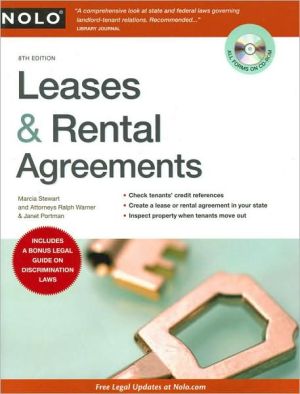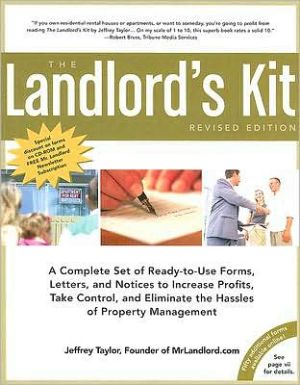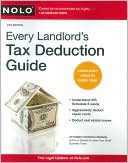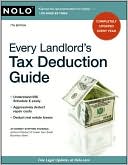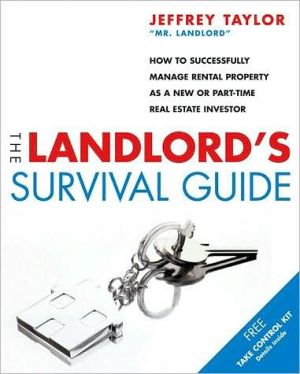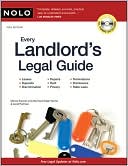Leases and Rental Agreements
Rent your property now with this quick and easy handbook.\ \ Here's a quick way for landlords to create the key documents necessary for owning or managing rental property, including a legally valid lease or rental agreement.\ \ With this bestselling guide, you'll learn how to:\ \ • prepare a rental agreement or lease\ • tailor your documents to meet your needs\ • make required disclosures\ • comply with your state's laws on security deposits, privacy rules, discrimination and more\ • check...
Search in google:
Rent your property now with this quick and easy handbook.Looking for a quick way to create the key documents necessary for owning or managing rental property, including a legally valid lease or rental agreement? Leases & Rental Agreements provides the practical and legal information necessary to rent out your property in record time -- and without a pricey attorney. Leases & Rental Agreements includes tear-out forms (plus step-by-step instructions to fill them out), including a rental agreement, lease, rental application and more. Complete these forms by adding the needed information by hand or by using a typewriter, or fill in the documents on your PC using the enclosed CD-ROM. The 8th edition provides updated 50-state legal charts on security deposits, rent rules, access to rental property and more, plus an expanded chart on your state's disclosure laws. Robert Bruss On my scale of one to 10, this excellent book rates a solid 10.
Introduction\ The rental agreement or lease that you and your tenant sign is the contractual basis of your relationship. Taken together with the landlord-tenant laws of your state -- and, in a few areas, local and federal laws -- it sets out almost all the legal rules you and your tenant must follow. Your rental agreement or lease is also an immensely practical document, full of crucial business details, such as how long the tenant can occupy your property and the amount of the rent.\ \ Given their importance, there's no question that you need to create effective and legal rental \ agreements or leases with your tenants. This book shows you how, by providing clearly written, fair, \ and effective lease and rental agreement forms, along with clear explanations of each clause.\ \ Our agreements are legally accurate and up to date, based on careful research of every state's \ landlord-tenant laws. They can be tailored to fit the details of your situation using the 50-state law charts in Appendix A. Throughout the book, we suggest ways to do this.\ \ In addition to showing you how to prepare a lease or rental agreement, this book also covers key legal issues that landlords need to understand, including how to legally choose tenants and start a tenancy. It also highlights the legal and practical issues involved with changing or ending a tenancy. This book provides forms that supplement a lease and a rental agreement, including a rental application designed to help you choose the best tenant. Other forms, such as a Landlord-Tenant Checklist (used to document the condition of the rental unit at the beginning and end of the tenancy), will help you avoid legalproblems with tenants, such as disputes over security deposits.\ \ The lease and rental agreement and other forms included in this book are on the Landlord Rental Forms CD. We also include tear-out versions of these \ forms in Appendix C at the back of the book. The CD-ROM also includes a special legal guide to complying with discrimination laws.\ \ Who shouldn't use our lease or rental agreement? Don't use the forms in this book if you're renting out property that is subsidized by \ the government, such as the Section 8 program of the federal Department of Housing and Urban Development. You may need to use a special government-drafted lease. Also, our forms should not be used for renting out mobile homes, townhouses, hotels, or commercial property. If you are renting out \ your condominium or townhouse, use this book in conjunction with your homeowners' association's rules \ and regulations (called CC&Rs, or covenants, conditions, and restrictions). These CC&Rs may affect how you structure the terms and conditions of the rental and how your tenant uses the unit.\ \ Other Nolo Books and Products for Landlords\ A lease or rental agreement is only one part of a landlord-tenant legal relationship. For example, \ many state (and some federal and local) laws are also extremely important. A comprehensive explanation of these laws, and the practical steps rental property owners can take to comply with them (while at the same time running an efficient and profitable business), is covered in Every Landlord's Legal Guide, by Marcia Stewart, Ralph Warner, & Janet Portman (Nolo).\ \ It covers most key laws affecting landlords in all 50 states, including your repair and maintenance responsibilities and your liability for crime and environmental hazards such as lead; rules and procedures for collecting and returning security deposits; antidiscrimination laws; privacy rules; employment laws affecting managers; how to resolve problems with tenants or begin the eviction process; and more. Every Landlord's Legal Guide includes over 20 legal forms on CD and in tear-out form.\ \ Nolo's other landlord titles include:\ \ \ \ \ Every Landlord's Guide to Finding Great Tenants, by Janet Portman, a comprehensive guide to attracting, screening, and choosing the best tenants possible\ \ \ Every Landlord's Tax Deduction Guide, by Stephen Fishman, a detailed explanation of\ deductions and other tax write-offs available to landlords\ \ \ The California Landlord's Law Book: Rights & Responsibilities, by David Brown, Ralph Warner, & Janet Portman\ \ \ The California Landlord's Law Book: Evictions, by David Brown, and\ \ \ LeaseWriter Plus Landlord Software.\ \ \ \ \ \ You can order these landlord titles from Nolo's website (www.\ olo.com) or by phone (800-728-\ 3555). You can also find Nolo books at bookstores and libraries.\ \ Be sure to check out the Nolo website, which has lots of free information of interest to landlords, including legal updates. On the home page, choose Property and Money, then Landlords and Property Management.\ \ 11 Tips for Being a Successful Landlord\ 1. Don't rent to anyone before checking their credit history, references, and background.\ Haphazard screening too often results in problems -- a tenant who pays the rent late or not at all, trashes your place, moves in undesirable friends, or worse.\ \ 2. Avoid illegal discrimination. Comply with all federal and state laws prohibiting discrimination on the basis of race or color, national origin, gender, age, familial status, or disability. (See Chapter 3 for an overview of the topic and the special legal guide "Complying With Discrimination Laws" on the Landlord Rental Forms CD.)\ \ 3. Get all the important terms of the tenancy in writing. Beginning with the rental application and lease or rental agreement, be sure to document important facts of your relationship with your tenants -- including when and how you handle tenant complaints and repair problems, notice you must give to enter a tenant's apartment, and the like.\ \ 4. Establish a clear, fair system of setting, collecting, holding, and returning security deposits. Inspect and document the condition of the rental unit before the tenant moves in to avoid disputes over security deposits when the tenant moves out.\ \ 5. Stay on top of repair and maintenance needs and make repairs when requested. If the property is not kept in good repair, you'll alienate good tenants. And they may have the right to withhold rent, sue for any injuries caused by defective conditions, or move out without notice.\ \ 6. Don't let your tenants and property be easy marks for a criminal. You could well be liable for the tenant's losses. Landlords are sued more than any other group of business owners in the country. The average settlement paid by a landlord's insurance company is $600,000, and the average jury award is $1.2 million.\ \ 7. Respect your tenants' privacy. Notify tenants whenever you plan to enter their rental unit, and provide as much notice as possible, at least 24 hours or the minimum amount required\ by state law.\ \ 8. Disclose environmental hazards such as lead. Landlords are increasingly being held liable for tenant health problems resulting from exposure to environmental poisons in the rental premises.\ \ 9. Choose and supervise your manager carefully. If a manager commits a crime or is incompetent, you may be held financially responsible. Do a thorough background check and clearly spell out the manager's duties to help prevent problems down the road.\ \ 10. Purchase enough liability and other property insurance. A well-designed insurance program can protect your rental property from losses caused by everything from fire and storms to burglary, vandalism, and personal injury and discrimination lawsuits.\ \ 11. Try to resolve disputes with tenants without lawyers and lawsuits. If you have a conflict with a tenant over rent, repairs, your access to the rental unit, noise, or some other issue that doesn't immediately warrant an eviction, meet with the tenant to see if the problem can be\ resolved informally. If that doesn't work, consider mediation by a neutral third party, often available at little or no cost from a publicly funded program. If your dispute involves money and all\ attempts to reach agreement fail, try small claims court, where you can represent yourself. Use it to\ collect unpaid rent or to seek money for property damage after a tenant moves out and the deposit\ is exhausted.\
1. Being a Successful Landlord2. Preparing a Lease or Rental Agreement3. Choosing Tenants: Your Most Important Decision4. Getting the Tenant Moved In5. Changing or Ending a TenancyAppendix 1. State Landlord-Tenant Law ChartsAppendix 2. Tear-Out Forms
\ Robert BrussOn my scale of one to 10, this excellent book rates a solid 10.\ \ \ \ \ Library JournalAimed at owners and managers of residential rental property, this new collection of forms and guidelines is designed to help with the creation of leases, rental agreements, and related documents. The authors' legal advice is accompanied by sound suggestions for managing rental arrangements. Stewart and Warner build the documents from the ground up by defining terms, enumerating issues to consider, offering alternative clauses, and highlighting problem areas. In an especially good discussion of choosing tenants, readers will find counsel on advertising property, checking references, and avoiding discrimination. Forms for consent to background check, rental application, and tenant references complete the discussion. The plentiful tables include references to state laws on security deposits, landlord access to rental property, and lists of states that limit security deposits. An appendix offers tear-away forms that cover a number of common landlord/tenant situations. This book works well with the authors' Every Landlord's Legal Guide (LJ 4/15/96), a comprehensive look at state and federal laws governing landlord-tenant relations. Recommended for most public libraries.-Joan Pedzich, Harris, Beach & Wilcox, Rochester, N.Y.\ \ \ From The CriticsLeases & Rental Agreements provides owners of real estate with a quick do-it-yourself handbook for renting out a property, including tear-out legal forms and tips on preparing different types of rental or lease agreements. From making disclosures on hazards to complying with laws covering security deposits and privacy, this provides all the details necessary.\ \ \ \ \ Financial Magazine Kiplingers Personal"A valuable copendium of musts andmust-nots for landlords that offer legal tips and plenty of practical advice."\ \ \ \ \ Picayune New Orleans Times"...remarkably complete in its scope. From screening tenants to basic rent rules to resolving rental problems with -- and without -- the help of lawyers, the authors provide a look into the life of a landlord showing how to avoid legal traps and how to set up safeguards."\ \ \ \ \ San Diego Union-Tribune"All the rental forms you'll ever need."\ \
